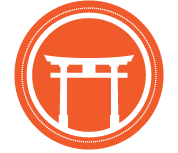Is Dojo Etiquette Necessary?
Inryoku Volume 5 Issue 5
By Josh Paul, AOSB head instructor
Throughout Japan, there are gates, or torii, marking the entrances to Shinto shrines. These shrines are specific locations dedicated to one or more of the many Shinto kami (gods). There are shrines devoted to aikido, business, harvests, good hair, geisha—basically everything.
Today, the shrines are open-air locations for weddings, festivals, funerals, socializing, and contemplation. Some are small, scattered, anachronistic blips in modern cities, while others are large parks that dominate small, rustic towns. The torii are doorways that mark the separation of the mundane, everyday world, from the special, spiritual world contained within. The torii separate the realms of the sacred and profane.
The design of the torii in the AOSB logo is based on the torii at the Fushimi Inari shrine, located outside of Kyoto, Japan. Fushimi Inari is situated at the base of Inari Mountain, and has approximately 2.5 miles of twisting trails leading to the mountaintop. The trails are lined with bright orange torii, punctuated periodically, and seemingly randomly, by shrines, scenic outlooks, and ohaka (Japanese burial sites). Fushimi Inari is constantly evolving and changing. Torii at Fushimi Inari are always being added and replaced through the contributions of supporters.
Our logo is intended to serve as a reminder that when entering the dojo, you are entering a special and unique (dare I say sacred?) space devoted to personal evolution and change. The dojo is a space separate and different from the mundane world, and when we pass through that metaphorical gate, we leave our mundane worries, cares, and attitudes outside. The logo is also a reminder that our aikido, like Fushimi Inari, changes and grows within a traditional structure.
The word dojo means “place of the way.” It is a unique space dedicated to the pursuit of learning, meditation, and growth. The dojo is a brick and mortar establishment as much as it is an idea. Any place “the way” is practiced could be a dojo. A dojo does not have to be defined by its architecture or interior decor. A dojo is mostly defined by the people who gather and practice there.
The dojo is more than a physical space. It is a culture, too. To maintain the dojo’s “mystique,” our manners, dress, and behavior—our etiquette—should more formal and deliberate than elsewhere. This begins by understanding and remembering that we are dojo members, not clients or customers. Membership is a privilege, not a purchase.
“Ira: Dada, we need to go to the dojo.
Dada (i.e., Josh Sensei): What’s the dojo?
Ira: It’s the place of the way.
Dada: What’s the way?
Ira: You go down Sackett St. and turn at the corner. ”
In the broadest sense, dojo etiquette simply means being polite, respectful, and unobtrusive. It means being helpful, treating others as you wish to be treated, and practicing safely. Etiquette is putting the needs of the dojo and the community ahead of personal needs. Yes, the dojo is hierarchical, but the hierarchical structure primarily exists to ensure a fulfilling training experience for everybody. New students are expected to bring excitement and curiosity. Senior students are expected to transmit the art and culture. Together, everybody is expected to create aikido (the binding together of attractive forces, i.e., inryoku), and keep the dojo safe, clean, and accessible for everybody on the path.




